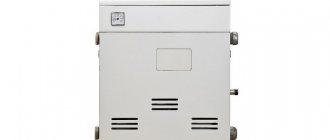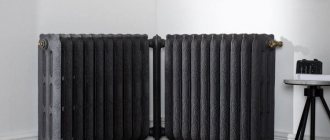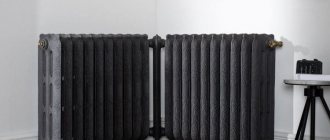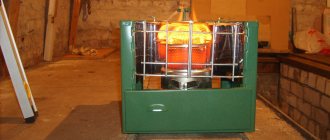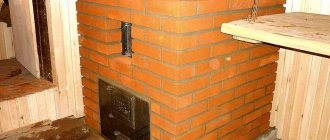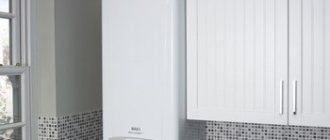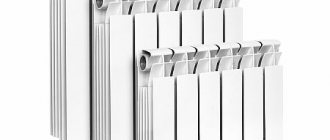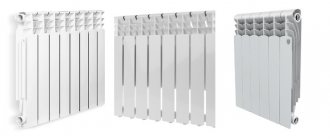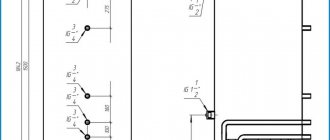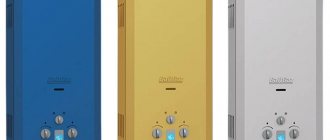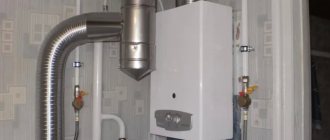Warning
: Use of undefined constant callback_thumbing_img — assumed 'callback_thumbing_img' (this will throw an Error in a future version of PHP) in
/var/www/u1241734/data/www/birzhaplus.ru/wp-content/themes/sreda-design- nocat/includes/kama_thumbnail.php
on line
337
A special type of modernized batteries are vertical heating radiators for an apartment. They are not installed in a window sill niche, but are hung directly on the wall near panoramic windows, balcony or interior doors. Most models have excellent design, but it is important to know the features of these heating devices.
A mandatory element of any living space is a heating system, in particular radiators.
What are vertical heating radiators
When purchasing real estate, you often have to make repairs, including replacing heating appliances. Even with the usual modernization of an apartment, it is often necessary to change the batteries, which are hopelessly clogged and practically do not heat.
In addition to the usual models located under window openings, today there are vertical analogues installed on walls.
When studying offers from heating equipment catalogs, potential buyers often pay attention to vertical radiators for heating an apartment. They differ from classic batteries in their unusual design and proportions, as well as in the absence of the need to look for a special place for them.
As a rule, a vertical heater is a painted metal panel or a tubular cascade in a modern design. They fit perfectly into most styles, have excellent thermal output and excellent appearance, as in the photo.
It is logical that heating radiators are called vertical, the sections of which are located vertically.
Vertical designer radiators are distinguished by their design and more respectable appearance. Behind the elite appearance are ordinary pipes for supplying hot water or antifreeze, but their price is justified by the harmonious appearance.
Advantages and disadvantages
The positive aspects of a vertical radiator include both practical and aesthetic design features:
- Rational use of indoor space. Greater thermal power can be fit into a rather narrow wall space by increasing the vertical heat exchange area.
- Propagation of thermal radiation over the entire height of the battery. The location and height of the heating radiator itself can bring many pleasant moments to a person, especially when entering a room from the cold.
- The maximum range of models that will allow you to implement any design solution.
- Additional functions allow you to turn heating radiators into vertical mirrors, clothes dryers, decorative partitions and panels.
- Due to the smaller movement of warm air from the lower layers to the upper layers in the room, the movement of dust is also limited.
New items in the model range in the form of a mirror frame, a solid or lattice wall panel, a matte or painted partition are increasingly finding their fans among room designers, and variations in sizes from very narrow to very wide allow you not only to correctly adjust the temperature in the room, but also to direct warm.
Of course, such extraordinary solutions also have disadvantages:
- Heat transfer is built irrationally. That is, the top of the room is warmer than the bottom due to the accumulation of warm air under the ceiling. However, many people find some advantages in this in the form of warm stairs and interfloor passages, which perfectly heat the installed radiators on the lower floor.
- High probability of air pockets.
- Connection difficulties. It is necessary to carefully hide all supply pipes and fastenings to maintain an aesthetically pleasing appearance. Vertical and horizontal deviations are also unacceptable. It is necessary to use a bottom connection, which is rarely optimal for heat transfer.
- The requirements for high wall strength come from the massiveness of the structure. The radiators are quite large in size, and although they seem quite light without filling, their weight, including water, is quite large. This imposes some restrictions on placement on the walls.
- The cost of vertical models is often much higher than the price of traditional options.
Today's wealth of shapes, layouts and variations of interiors cannot be heated by every horizontal heating element, so installing vertical heating radiators in many cases serves as a salvation. A variety of models and designs provide an excellent opportunity to competently combine rationalism and creativity, because such unusual and attractive designs will serve well for many years.
Pros and cons of vertical format radiators with bottom connections
The excellent design of a vertical panel or tubular heating radiator is the main advantage of this format. They fit perfectly into most modern design concepts. Some models can hardly be called a “battery” until you touch a warm surface with your hand.
A distinctive feature of such systems is their orientation in height with a reduced width.
Vertical units are installed in addition to horizontal equipment or instead of traditional batteries. It is easier to find a place for them when there is no window sill niche or it is not spacious enough to install a large heating unit. They are characterized by:
- high thermal output;
- variety in color and design;
- ease of installation (all parts for installation are included);
- space saving (a little space in width on any free wall).
Among the “disadvantages” are:
- more time is needed for “acceleration” during primary heating;
- uneven heating at high altitude and insufficient pressure in the system;
- relatively high price;
- tendency to clog in the lower part of the radiator, where the coolant is supplied.
The main sign of contamination is cold radiators and warm pipes that are connected to them. Since all the dirt accumulates at the bottom, they have to be disconnected periodically and purged or washed. An exhaust valve must be installed at the top point to remove excess air.
Thanks to this arrangement, it is possible to fit such batteries even into a small space, maintaining the required amount of thermal energy.
How to choose the right one
The question of choice is always of interest to consumers, especially when it comes to tall units. First of all, you need to take into account the height of the ceilings, since it can be 2.5 meters, and the products have a size of up to 3 meters. The main thing here is not to make a mistake, otherwise the product simply won’t fit.
For apartments and children's rooms it is better to take tubular models. They best meet the requirements and are safer.
Tubular radiators have a number of advantages:
- withstand pressure up to 10 atmospheres;
- connected by laser welding;
- smoothed corners prevent injury;
- uniform heating of the room;
- convenient cleaning.
The second point is the amount of heat required for a comfortable microclimate in the room. And in this regard, tubular models are convenient, since they can have from 1 to 6 rows in depth. If the unit will be mounted in a wall, you must first measure its width.
For private houses, the type of radiator is not of fundamental importance, since the pressure in the autonomous system is low and there is no risk of ruptures. Cast iron, aluminum, bimetallic, and steel models are suitable here. The main thing is that they fit harmoniously into the interior and evenly warm the room.
Types of vertical radiators on the wall
Today, many interesting models of heating equipment have been developed that can easily replace old rusty pipes and clogged cast iron accordions. New types of batteries, including vertical ones, are classified according to different criteria:
- metal (cast iron, steel, aluminum, bimetal);
- mounting method (floor with legs, wall with brackets);
- functionality (radiators and heated towel rails);
- by external design (tubular, panel, sectional);
- according to the method of connection to the heating system (side, diagonal, bottom “saddle”).
The systems can be located almost from the floor to the flow, up to the height of a person.
From all the variety you can choose the most suitable model. It should be recalled that vertical tubular panels fit perfectly into the design of an insulated balcony or loggia. They are mounted on the end walls on both sides to ensure full convection.
By spreading infrared thermal radiation (similar to solar heat) at the height of a person, they provide increased indoor comfort.
Cast iron heaters
Cast iron products are considered “classics”, since this is the format of heating equipment that has been used for almost a century. The main disadvantage is that they are heavy and bulky; there are certain difficulties when installing them yourself.
Due to their high performance properties, cast iron batteries are very popular.
An important advantage of this type of vertical radiators is their inertness to the composition of the coolant. They do not react to the composition of water and its acidity, and are not prone to corrosion. However, organic suspension, calcium deposits and rust, which was brought from the heating circuit pipes, quickly accumulate in cast iron sections.
Steel radiators
The most common material for heating devices. Stainless steel is lightweight and ductile for the manufacture of batteries of any format. But we can say that it is “stainless” only conditionally. In terms of other performance parameters, these batteries have practically no equal.
Steel radiators are quite in demand, which is primarily due to their affordability.
Modern alloys are quite resistant to chemical reactions. Internal chrome plating of surfaces minimizes the corrosion process. But over time, small abrasive particles of the coolant cause damage to the protective layer. The air and moisture that remains in heating devices in the summer after draining the water gradually destroys the “stainless” steel.
Aluminum batteries
A lightweight, ductile metal, aluminum has proven itself well in vertical radiators. They do not require additional painting, searching for a suitable decorative shield or other design technique.
The product is lightweight, neat in appearance, durable and affordable.
However, all-aluminum radiators for urban environments are rarely preferred. Most often, bimetallic models are made from this metal, where only the external parts are aluminum. The coolant flows through a steel tube. This soft ductile metal also has disadvantages:
- incompatible with copper, which is found in heating boiler parts;
- connecting units cannot withstand the maximum load during water hammer (cracks, depressurization, leaks are possible);
- With sudden mechanical shocks, the radiator may lose its impeccable appearance (scratches, dents).
Lightweight products of modern design, resistant to corrosion are the main positive characteristics. Vertical models are often produced not only from aluminum, but from bimetal and in the form of combined design proposals.
The products are characterized by high thermal efficiency, but overheating is possible in the fin area.
Helpful information! The catalogs contain not only aluminum radiators, but also offers in the form of vertical heated towel rails and horizontal benches with wooden seats for heated bathrooms.
These are models with different functionality, but they are more suitable for a closed heating circuit in cottages and large country buildings.
The most efficient and reliable systems consisting of an inner and outer pipe.
Bimetallic heating devices
This type combines the advantages and disadvantages of 2 types of heating devices for a comfortable apartment microclimate:
- aluminum;
- steel.
Typically this is a steel tubular base in an aluminum casing. A mixed-type bimetallic battery withstands water hammer and low quality warm water in urban systems. But over time, the protected inner layer of galvanization wears off under the influence of small abrasive particles, they rust and fail.
The material for the outer pipe is usually aluminum with an enamel coating.
Externally, vertical bimetallic panels are perfectly perceived in a modern interior. They do not have to be hidden behind curtains, screens or furniture, as is often necessary with old cast iron products.
Material selection
The main feature that allows us to classify vertical radiators is the source material from which each of the products in question is made. In accordance with this criterion they are:
- made of cast iron or steel;
- aluminum;
- bimetallic;
- based on copper and plastic (extremely rare).
Cast iron batteries
Cast iron vertical heating radiator
Heating radiators made of cast iron are classic models that were widespread in past centuries. They are still in demand among consumers, which is explained by their following advantages:
- product strength;
- relatively low price;
- durability.
On the other hand, this material has a number of significant disadvantages, which forced manufacturers to master the production of modern samples based on more “advanced” materials:
- difficulty of installation due to the significant weight of the mounted systems;
- fragility of cast iron material, inability to withstand impact loads;
- low thermal conductivity, forcing an artificial increase in the temperature of the coolant.
If you need to heat cast iron batteries to 45 degrees, the water temperature in them will have to be raised to 70 degrees. As a result, there is an overconsumption of energy resources, which is especially noticeable during the heating season in private suburban buildings. Therefore, for a private consumer, the problem of economy is decisive when choosing a material for a heating device.
Aluminum products
Aluminum vertical radiator
A vertical tubular radiator based on aluminum looks much more attractive than cast iron samples of the same class. In addition, the thermal conductivity of such heating elements is much higher.
Before purchasing aluminum batteries for a private home, you should consider that they are sensitive to the quality of the coolant water. If the supplied liquid is heavily contaminated and there are no filters at the system inlet, it is not advisable to use them in private homes. Without special media cleaning, aluminum radiators will quickly fail. On the other hand, installing filter elements will require additional costs. Their disadvantages also include the inability to operate at high water pressure.
Steel radiators
Decorative steel heating radiator
Steel radiators are a typical example of “advanced” heating systems, having two different designs: tubular and panel. The latter option is positioned as a budget option and is somewhat inferior to tubular products in terms of heat transfer. On the other hand, such radiators are unpretentious in operation and are in demand in private homes, where additional filtration of the coolant is not provided.
Unlike panel samples, tubular steel batteries are classified as elite models, characterized by the following advantages:
- high level of thermal output;
- efficiency;
- attractive design;
- durability (the service life declared by the manufacturer is about 25 years).
Due to their attractiveness, tubular radiators are often used as a decorative element in a living space.
Among the models of this class, steam heating batteries made of stainless steel stand out.
Steel batteries have an undoubted advantage over products made from other materials, since their heat transfer is much higher.
Bimetallic radiators
Bimetallic radiator
Bimetallic radiators are a separate group, representing a worthy choice for any living space. They are made from two metals. They use steel pipes as a load-bearing base, on which aluminum ribs are attached on top.
Combined radiators have a number of advantages:
- Long service life - according to the manufacturer, they reach 30 years.
- The core is made of high-carbon steel, thanks to which the bimetallic radiator received the necessary strength.
- High level of heat transfer - up to 190 W per section.
- A wide selection of items, differing in their design and colors.
The standard kit includes a temperature controller that allows you to change the heat output over a wide range.
Disadvantages of combined products:
- direct contact of two metals having different expansion coefficients leads to the appearance of extraneous sounds during operation of a bimetallic radiator;
- Small sizes of inlet and outlet pipes often cause blockages, especially if there are a large number of foreign particles in the coolant.
- the need to install a filter element at the inlet.
The relative disadvantages of these radiators include their high cost.
What size of wall-mounted water heating radiator to choose
If we talk about the dimensions or dimensions of vertical radiators for an apartment, then they are less limited. Horizontal type batteries should be placed in a niche under the window. There are certain requirements that are important to comply with in order to have maximum thermal output.
The decisive criterion when choosing a heating radiator is its heat transfer.
Popular height formats range from 1200 – 1500 and up to 2000 mm. Large panels are used in rooms with high ceilings and specific “concrete jungle” rooms:
- loft apartments;
- apartments with panoramic views;
- housing with “French” windows (low window sill);
- apartments with hinged balcony doors with glazing.
The power of the system is selected taking into account the area of the room, the presence and number of walls in contact with the street.
Vertical wall-mounted thermal units have fewer format restrictions. Of course, compact designer panels are easier to integrate into interior design. But tall and deep models give off more heat, provided that they are not dirty and connected correctly.
Mirror and flat models
Nowadays you can find the most unusual options. In this case, mirror and flat radiators of the vertical type are popular. The front plane of the mirror radiator has a mirror surface. Such a radiator will bring not only warmth, but also beauty to your home. They are usually made in standard colors - black and white. Mirror radiators can be installed in any room - they have a nano-coating and good anti-corrosion characteristics.
Glass vertical radiators
There are also flat models of vertical radiators. Such models look elegant in the interior. As for the sizes, they can be 1-, 2-, 3-row. Such radiators may also have convective plates. Thanks to the smooth surface, dust does not collect on such devices, and therefore the heat transfer will be higher.
Such radiators are compact and injury-proof, they are designed vertically, the volume of coolant here is small, so it heats up quickly.
Such batteries are not installed deeply and are easy to remove. You can also perform them in a radius or angular version. In any case, such batteries have a large percentage of heat radiation.
How to choose a vertical radiator based on its thermal power
Heating devices made from different metals have different heat capacity indicators, and the efficiency depends on their shape. Therefore, it is important to take into account not only external parameters, but also all these relationships when choosing one or another vertical model.
For an apartment where the likelihood of water hammer occurring is higher than in a private house, it is better to choose cast iron or bimetallic products.
Note! The technical description for each product indicates the thermal output. The ratio of calories supplied must match the footage or volume of heated air in the room.
In some cases, it is necessary to combine horizontal and vertical batteries to provide full heat. These are corner rooms in houses without external insulation with an open loggia.
For unusual interiors, you can choose designer radiators.
An additional vertical block behind the balcony door, as in the photo, will add warmth on cold winter evenings.
Important! To carry out the most accurate calculations of the ratio of heating devices and battery format, there are special formulas and computer programs. They include all coefficients and amendments regarding footage, climatic conditions of the region and other housing parameters.
Laconic batteries with a single color will fit into almost any interior.
Features of installing high radiators
Connecting batteries of any format has a lot in common, regardless of the model type. Connection to the heating riser is made in different ways:
- diagonal (most effective);
- lateral (standard);
- bottom connection.
Among steel elements, tubular systems are considered the safest.
Helpful advice! Before purchasing, it is important to make sure what type of connection this model will correspond to.
Vertical panels are usually connected from below, but, if possible, it is better to weld the pipes to make a diagonal coolant supply. It will ensure the most efficient filling of the battery with warm water before returning to the return line.
Vertical batteries must be installed on reinforced walls, otherwise, due to the heavy weight, the structure will simply fall, tearing out part of the wall.
With a lower connection, all recommendations remain the same as for horizontal cast iron accordions. But vertical models have one feature - the water pressure in the system should be enough to fully fill the heating equipment.
Installation Features
What must be taken into account during installation
For effective heating of premises, it is necessary to comply with a number of simple requirements during installation:
- Given the significant size and weight of the device, it must be attached to load-bearing walls or strong interior partitions, reinforcing them if necessary.
- On the pipelines connecting each radiator, it is advisable to install a jumper (bypass) with a shut-off valve, a thermostatic valve and shut-off valves, which allow you to effectively and economically control the operation of the heating device.
- An air vent valve (Mayevsky tap) must be installed in the upper part of the battery , while it would be preferable to install an automatic air vent valve.
- For a more aesthetic appearance, it is better to purchase radiators with lower connections that hide the pipes connected to the battery.
- A lateral or diagonal connection should be made if it is possible to conduct hidden pipe wiring in the walls.
- When connecting to a central heating system, it is undesirable to use panel-type radiators, which are sensitive to sudden changes in operating pressure.
- You can use almost any type of heating pipe for connection. But it is better to give preference to plastic pipes (metal-plastic, polypropylene) - they are easy to install, do not require welding, they are reliable and durable in operation.
- It is extremely undesirable to connect copper pipelines to aluminum radiators, as this causes rapid oxidation and destruction of such connections (more about the characteristics of aluminum).
READ ALSO: Review of vacuum heating radiators
Famous brands of heating radiators
The production of designer and vertical blocks is carried out by:
- Arbonia;
- Global,
- Zehnder;
- Enix;
- Kermi;
- Bethatherm.
Their certified products can be viewed in catalogs on official websites and in specialized retail outlets.
The designer batteries, which can be made using various decorative techniques, evoke admiration.
As you can see, the classic horizontal cast iron accordions have a worthy alternative - vertical radiators that are excellent in design.
Cons to be aware of
When buying radiators of a vertical design, you need to know about their disadvantages:
- In general, such batteries have a lower heat transfer than with the same area of a conventionally shaped battery.
- The cost of such a battery does not fall into the consumer price category.
- Most of the heat will be dissipated under the ceiling, and this is, in essence, useless heat transfer. From the point of view of the laws of convection, horizontal batteries are more appropriate.
It can be assumed that a large area of glazing in buildings is done in regions with very warm winters. However, in such cases, conventional air conditioners or “heat guns” will give a better effect than vertical radiators.
